#Thutmose I
Text
Legendary Warrior Women of the Ancient World
Once upon a time, there were women who challenged the might of empires and the laws of men.
They beckoned a world where the whisper of a woman's voice could quake the thrones of tyrants.
Let's delve into these legends from antiquity. 🧵⤵️
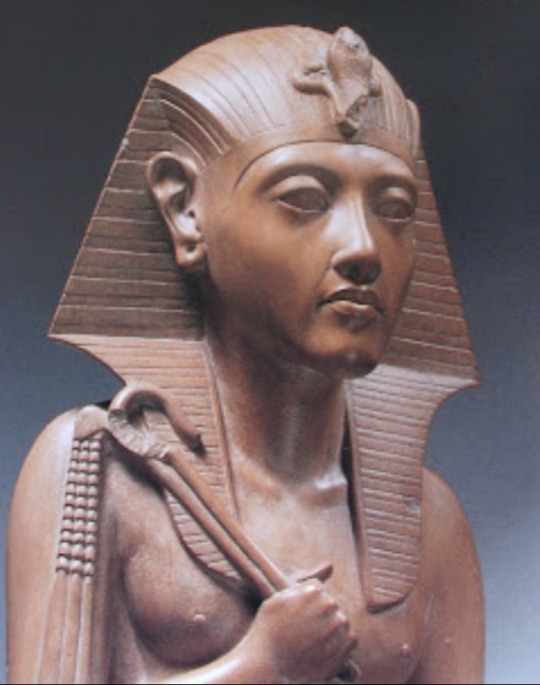
Hatshepsut
The fifth pharaoh of the Eighteenth Dynasty of Egypt, Hatshepsut reigned longer than any other woman of an indigenous Egyptian dynasty.
She was one of the most prolific builders in Ancient Egypt.
To legitimize her reign, Hatshepsut claimed she was divinely conceived by the god Amun, who appeared to her mother in the guise of the pharaoh Thutmose I, her father.

Sappho
An ancient Greek poet from the island of Lesbos, Sappho is celebrated for her lyric poetry, which explores love and passion.
Legend says that Sappho leaped from the Leucadian cliffs due to her unrequited love for Phaon, a ferryman, demonstrating the depth of her emotional expressions that permeated her work.

Artemisia I of Caria
A queen of the ancient Greek city-state of Caria and an ally of Xerxes I during the Second Persian invasion of Greece.
In the Battle of Salamis, Artemisia was so cunning in combat that she intentionally rammed her ally's ship to escape the Greeks, convincing them she was an ally and thus avoiding capture.

Hypatia
A mathematician, astronomer and philosopher in Alexandria, Egypt, Hypatia was a renowned teacher and thinker.
Hypatia was known to drive through Alexandria in her chariot to deliver public lectures on philosophy, defying the gender expectations of her time.
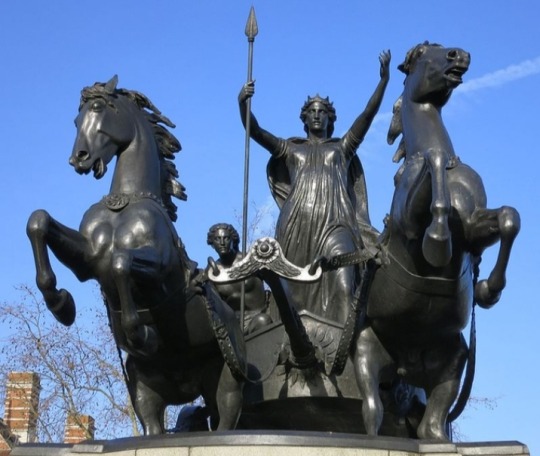
Boudicca
The warrior queen of the Iceni tribe who led a major uprising against the occupying forces of the Roman Empire in Britain.
After the Romans flogged Boudicca and raped her daughters, she rallied her tribe and neighboring tribes for revenge, resulting in the destruction of Roman settlements and the decimation of the Roman Ninth Legion.
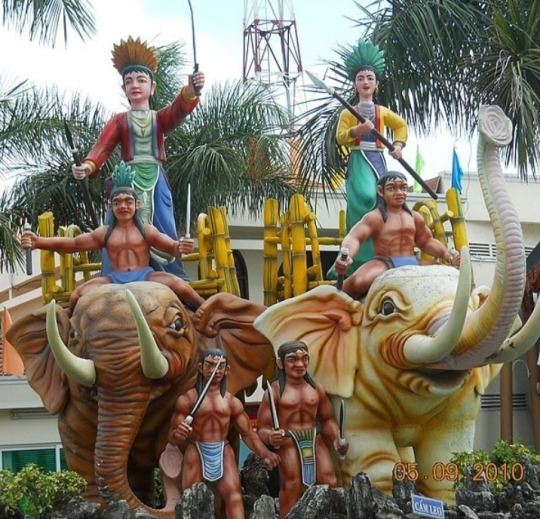
The Trung Sisters: Trung Trac and Trung Nhi
Vietnamese military leaders who rebelled against Chinese Han dynasty rule, becoming enduring symbols of resistance.
The sisters, after witnessing the suffering of their people under Chinese rule, famously declared their independence by proclaiming:
"All the male heroes bowed their heads in submission; only the two sisters proudly stood up to avenge the country."

Khawlah bint al-Azwar
A legendary female Muslim warrior, she fought alongside the early Muslims in the battles against the Byzantine Empire.
Khawlah famously donned male warrior’s armor to rescue her brother from a Byzantine prison camp, charging into battle with such ferocity that opponents assumed she was a supernatural entity.

Joan of Arc
A French heroine and saint of the Catholic Church, Joan led French forces to victory over the English at Orléans.
Joan persuaded a skeptical Charles VII of France of her divine mission to save France by correctly predicting a military reversal at the Siege of Orleans, before any messenger could have reached them with the news.

Zenobia
The third-century queen of the Palmyrene Empire in Syria who challenged the authority of the Roman Empire.
Zenobia was so bold that she claimed descent from Cleopatra, positioning herself as the Egyptian queen's successor in defiance of Rome and marched her armies as far as Egypt and Anatolia.
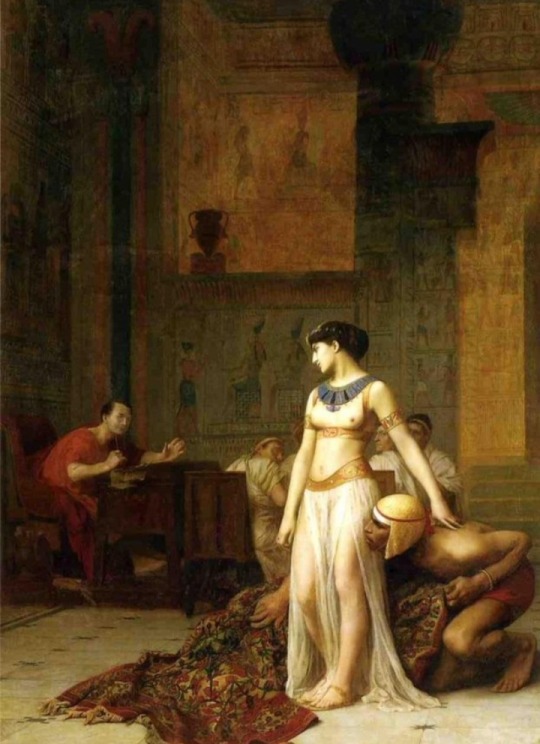
Cleopatra VII
The last active ruler of the Ptolemaic Kingdom of Egypt, Cleopatra is known for her intelligence, political acumen, and dramatic love affairs.
In a famous encounter to secure her alliance with Julius Caesar, Cleopatra had herself wrapped in a carpet (or linen sack, according to some accounts) and delivered to him, emerging to charm Caesar with her wit and beauty.
#female warriors#ancient civilizations#legendary warriors#Hatshepsut#Amun#Thutmose I#Sappho#Phaon#Artemisia I of Caria#Xerxes I#Hypatia#Boudicca#The Trung Sisters: Trung Trac and Trung Nhi#Khawlah bint al-Azwar#Joan of Arc#Charles VII of France#Zenobia#Cleopatra VII#Julius Caesar#ancient empires#ancient world#legends
5 notes
·
View notes
Text

From the temple of Seth
#Egypt#ancient egypt#egyptology#Thutmose I#tuthmosis I#djehutmose I#Seth#egyptian mythology#Sutekh#set#temple#Egyptian temple
4 notes
·
View notes
Text
I’m supremely bad at tying songs to characters, like really really bad so i very rarely do it, however one of very few songs i’m really attached to is life in b minor by orange culture for sonic. Last i checked the song still doesn’t have a transcript anywhere on the internet lmao so here’s my own under the cut + the mental gymnastics i’m doing



I said mental gymnastics but this is all really on the nose tbh
main street is breaking and there’s no one else around for a mile / and the cracks on the sidewalk multiply and spread like wildfire / like wildfire
the water’s rising you know
Adventure
time itself is unwinding
CD, 06, generations
a plague is spreading around
Metal virus, or a metaphor for eggman’s empire
the flag above our heads seems to wave with a middle finger
Eggman empire
and the sky is falling faster than it ever will, oh i hope
Sky falls and the world threatens to end a lot. Let’s hope this is as bad as it gets
oh my thoughts will slow me down and all the names are gone now, overtime / overtime
my feet are aching, wring me down and led me to doubt, into dust / into dust
Ngl a lot of these lines are intelligible even tho i tried my best, but this is self explanatory right? “Thoughts will slow me down” “my feet are aching” sonic is fast and runs, logical hazards. World’s on his shoulders n all
i might just be insane though
#the song has like less than 400 views on yt lol i just need to not be the only one thinking of this#other than a couple really specific things#p much the only other songs I associate w sonic are brain power by noma and run wild by thutmose and nombe#but those are more vibes based. kinda songs id make an amv to yk#rambles#musicposting
3 notes
·
View notes
Text
Valley of the Kings, Queen Hatshepsut, Rameses III Temples Luxor Egypt
Valley of the Kings – planetware
The extensive archeological sites around Luxor are alluring. Visiting them is an extraordinary opportunity, but there’s so much to observe, it’s a bit overwhelming. I’m taking several tours led by knowledgeable Egyptologists – with a one-day break in between explorations. Unable to join groups, my tours have been private with a guide and driver. When it’s just you…
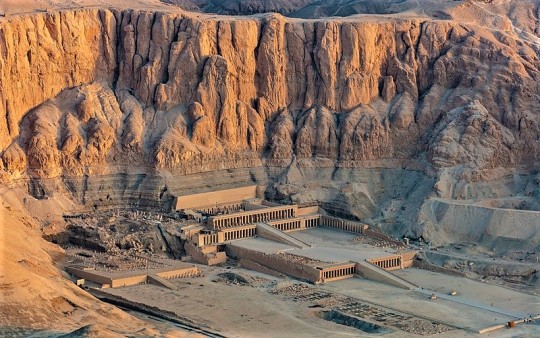
View On WordPress
#Amon God of the Air#Anubis Egyptian God of the Dead#Archaeologist Howard Carter#Book of the Dead#Egypt’s Oldest Funerary Book The Amduat#Egyptian Funerary Practices#Egyptian Limestone#Egyptian Mythology#Egyptian Pharaohs#God Horus#God Osiris#God Thoth#Goddess Nut Matriarch of the Egyptian Pantheon and Sky Goddess Nut#Hermopolitan Ogdoad#Hieroglyphs#Holy Theban Hills#Jackal-Headed Anubis God of Embalming and Friend of the Dead#King Thutmose I#King Thutmose II#King Thutmose III#Litany of Re#Lord Carnarvon#Medinet Habu#Mortuary Temple Hatshepsut Luxor Deir el-Bahari#New Kingdom – 18th to 20th Dynasties of Ancient Egypt#Pharaoh Hatshepsut II#Pharaohs XX Dynasty#Pleistocene Epoch#Queen Hatshepsut#Queen Hatshepsut Mortuary Temple
2 notes
·
View notes
Text

Dragging a Statue of Thutmose I - Met Museum Collection
Note: This is a modern copy of an original
Inventory Number: 15.5.17a
Original Dating: New Kingdom, Ramesside, Dynasty 19, ca. 1294–1279 B.C.
Location Information: From Egypt, Upper Egypt, Thebes
Description:
Thutmose I is represented here as a statue, as indicated by the men pulling him on a sledge. His black skin was initially understood to represent the ebony wood from which the statue was possibly made, but it most likely relates to the king’s deified state. Cults were established to worship kings during their reign. The cult of Thutmose I persisted for centuries after his death, a rare phenomenon, and this statue of the king is at the center of a scene depicting offerings and rites honoring him. Royal figures are sometimes depicted with a dark complexion, as the color black represents rebirth and regeneration–like the black soil of the Nile Valley.
#Dragging a Statue of Thutmose I#new kingdom#ramesside#dynasty 19#upper egypt#thebes#met museum#15.5.17a#mens clothing#NKRMC
0 notes
Text
i know the second i see spiderverse (this week!) my spotify wrapped is never going to recover
#the entire album from the first movie has been on my wrapped every year since it came out#what can i say i love some vince staples and thutmose#this should’ve gone on my spidey sideblog but w/e#that’s sp1dersense since im probably gonna be going nuts over there
1 note
·
View note
Text

Foundation Stone with Inscriptions
Egyptian, 1479-1458 BCE (New Kingdom)
Daughter of King Thutmose I and wife of her half-brother, King Thutmose II, Queen Hatshepsut eventually ruled Egypt as pharaoh in her own right. This commemorative stone was placed at a construction site, probably of the temple built for her at Deir el-Bahari, one of the most beautiful monuments of ancient Egypt. It bears the queen's throne name, Maat-ka-re, as well as that of the temple's architect, Senenmut.
102 notes
·
View notes
Text
Gallery Collection 001

Published: 2-21-2024 | Updated: N/A
SUMMARY
This is the first in a series of upcoming investment objects for Sims 2 – things your sims can use to generate income over time. From 1975-2000, Anheuser-Busch, Inc. commissioned 30 paintings of African kings and queens for an extended outreach and marketing campaign. This set of paintings features artwork from this amazing series. Celebrate Black History Month 2024! #co2bhm #bhm2024 #sims2bhm.
*No copyright infringement intended – I own no rights to these images.


DETAILS
Requires Sims 2. Requires Apartment Life for shiftability.
§1K-15K | Buy > Deco > Wall Hangings
Paintings are centered on 1-tile but cover more tiles than that. They come in various gallery sizes and images have been edited to fit the mesh. After purchase, their value increases by approximately 2% daily – watch out for burglars!
Files with “MESH” in their name are REQUIRED. Frame recolors include EA/Maxis and yeti textures. Frame and painting recolors are merged into two files so you’ll have to take them or leave them.
ITEMS
Great Kings & Queens of Africa: Paintings 001-006 (92-764 poly)
DOWNLOAD (choose one)
from SFS | from MEGA
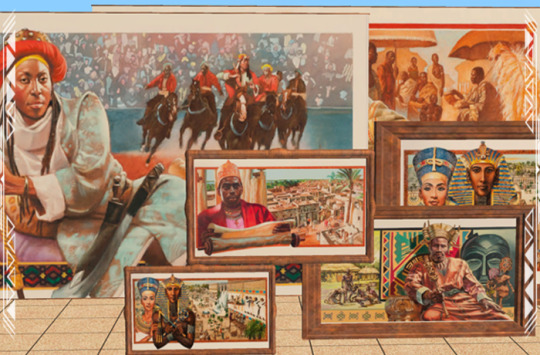

IMAGES
Akhenaton Pharaoh of Egypt (1375-1358 BC) by Barbara Higgins Bond
Alfonso I King of the Kongo (circa 1486-1543) by Carl Owens (1929-2002)
Askia Muhammaed Toure King of Songhay (1493-1529) by Leo Dillon
Benhanzin Hossu Bowelle—The King Shark (1841-1906) by Thomas Blackshear II
Cleopatra VII Queen of Egypt (69-30 BC) by Ann Marshall
Hannibal Ruler of Carthage (247-183 BC) by Charles Lilly
Hatshepsut The Ablest Queen of Far Antiquity (1503-1482 BC) by Dean Mitchell
Idris Alooma Sultan of Bornu (1580-1617) by Charles Lilly (1949-)
Ja Ja King of the Opobo (1821-1891) by Jonathan Knight
Khama III The Good King of Bechuanaland (1819-1923) by Carl Owens
Makeda Queen of Sheba (960 BC) by Debra Edgerton
Mansa Kankan Musa King of Mali (1306-1337) by Barbara Higgins Bond
Menelek II King of Kings of Abyssinia (1844-1913) by Dow Miller
Moshoeshoe King of Batsutoland (circa 1786-1870) by Jerry Pinkney
Mwana Ngana Ndumba Tembo—Ruler of the Angolan Tchokwe (1840-1880 circa) by Kenneth Calvert
Nandi Queen of Zululand (1778-1826 AD) by HM Rahsaan Fort II
Nefertari Nubian Queen of Egypt (192-1225 BC) by Steve Clay
Nehanda of Zimbabwe (1862-1898) by Lydia Thompson
Nzingha—Amazon Queen of Matambo (1582-1663) by Dorothy Carter
Osei Tutu King of Asante (circa 1650-1717) by Alfred Smith
Queen Amina of Zaria (1588-1589) by Floyd Cooper
Samory Toure The Black Napoleon of the Sudan (1830-1900) by Ezra Tucker
Shaka-King of the Zulus (1787-1828) by Paul Collins
Shamba Bolongongo African King of Peace (1600-1620) by Roy LaGrone
Sunni Ali Beer King of Songhay (circa 1442-1492) by Leo Dillon
Taharqa King of Nubia (710-664 BC) by John Thomas Biggers
Tenkamenin King of Ghana (1037-1075 AD) by Alexander Bostic
Thutmose III Pharaoh of Egypt (753-712 BC) by Antonio Wade
Tiye The Nubian Queen of Egypt (circa 1415-1340 BC) by Leonard Jenkins
Yaa Asantewa Queen of Ghana (1863-1923) by Barbara Higgins Bond
CREDITS
No copyright infringement intended – I own no rights to these images. Artwork and trademarks are the property of their respective creators and/or owners. If this exceeds fair use, please contact me via private message.
Thanks: Simming and Sketchfab Communities. Sources: Any Color You Like (CuriousB, 2010), Beyno (Korn via BBFonts), Console Certificates (d_dgjdhh, 2019; 2011), EA/Maxis, Gyeongbokgung Sajeongjeon Painting (National Heritage Administration, 2024 via CCA; Sketchfab), Great Kings and Queens of Africa Series (Anheuser-Busch, Inc., 1975-2000; Kentake, 2016), Offuturistic Infographic (Freepik), Painting by Zdzislaw Beksinski (Sosnowski, 2018 via CCA), Yeti Metals (Shastakiss, 2017).
76 notes
·
View notes
Text
Today I learned that the earliest named cat that we know of belonged to Puimre, Second Priest to Amun during the reign of the Egyptian Pharaoh Thutmose III. Her name is generally transliterated as either Nedjem or Nojem; either way, it translates to "Sweet One" or "Sweetie."
66 notes
·
View notes
Note
im devolving during my finals right now and i can’t think of any other way to say that hatshepsut and thutmose iii were rhaenyra and aegon-pilled. like the ptolemaic coding on the targs are sooooo clear but i think it’d be even more interesting to push them further back into archaic egyptian history. like the succession struggles between the two, the ideological divide between establishing herself as queen consort, queen regent, or queen regnant (but with all the masculine trappings of pharoanic power, which is kind of a fun parallel to show!rhaenyra’s whole ThingTM and conflict with gender performance and power). like i should be writing my final but i am instead turning this around in my head like an orb.
hold on i have to go look up a bunch of things
93 notes
·
View notes
Note
Hapshepsut?
Oh, you guys are funny. I make a note in my post about the oddity of people coming into my inbox with a single word prompt and that I have no idea how to respond except with a handful of information about the prompt, and now it's a real thing? That's just what I'm supposed to do?
Well, I might as well do so.
The modern legacy of Hatshepsut is dominated entirely by her womanhood. It completely disregards all of her accomplishments as a great and wealthy Pharaoh presiding over a time of great prosperity for Egypt, and it also overlooks the political and cultural climate of the time, which is as confusing as it is complicated.
This is much longer than my previous go about Ramses I, so I'm putting it under a read more.
Hatshepsut's Beginnings
When the layman thinks of Hatshepsut, they will think that she is the first female ruler of Egypt. This is their first mistake. There were many regents of Egypt; mothers who ruled on behalf of their young sons, who were not yet old enough to fully claim the throne. Beyond that there was also the female King Sobekneferu (12th Dynasty), as well as two Queens very early on in Egyptian history who might've been Pharaohs in their own right; Neithhotep (Early 1st Dynasty) and Merneith (1st Dynasty), both named for the warrior Goddess Neith, who held considerable importance in early Egyptian history. Both of these Queens have inscriptions and monuments attesting to their rule, but due to a lack of complete concrete evidence, it is difficult to now say whether they were regents or Pharaohs. Sobekneferu, from the 12th dynasty, was the first woman to take on the full royal titulary, assuming the position and title of Pharaoh completely. While her existence and rule is fully affirmed, there is little evidence left in the way of her accomplishments, as she ruled as the last Pharaoh of the 12th dynasty.
Khnumetamun Hatshepsut herself was born in 1507 BC to the Pharaoh Thutmose I and his Great Royal Wife, Ahmose. Her name, meaning 'Foremost of the Noble Women' was suiting to her––later in life she would be married to another one of her father's sons, Thutmose II, who was birthed of a secondary wife named Mutnofret. She was married before the age of 20 and assumed the highest standing title a woman could gain at the time; the God's Wife of Amun, giving her more power than even a Queen could achieve. To understand the importance of Hatshepsut even at this time, we must understand what it was to be the God's Wife of Amun. And remember, all this power and prestige is before she ever even became regent to her husband's son.
The God's Wife of Amun was a position held in Thebes, modern-day Luxor, and called Waset in ancient times. The title originates from the Middle Kingdom, and at that time, it was merely an honorific title for a noble woman who assisted the High Priest of Amun at Karnak Temple in his duties. By the New Kingdom, which was Hatshepsut's time, the God's Wife of Amun was powerful enough to influence policy and held considerable power and prestige, the peak of which was reached in the 3rd Intermediate Period, when a God's Wife of Amun ruled over Upper Egypt. The typical duties of a God's Wife of Amun were that of a high priest, and she would essentially be the female counterpart of the high priest of Amun, and took on many of his responsibilities alongside him. But the rewards for it were also plenty: "tax-exempt land, housing, food, clothing, gold, silver, and copper, male and female servants, wigs, ointment, cosmetics, livestock, and oil." (God's Wife of Amun, World History Encyclopedia, Joshua J. Mark) She would preside over the festivals of Amun and would be considered His consort, making her a divine being.
So this was Hatshepsut's position which was gifted upon her around the same time she was married to her half-brother, Thutmose II. Together they had a daughter whose name is Neferu-Ra, but this was their only child. The only viable heir to the throne after Thutmose II would have to be a son, which only came about through Thutmose II's lesser wife, Isis, who birthed Thutmose III. But Thutmose II, Hatshepsut's husband, died relatively soon after Thutmose III came to be, and so Thutmose III, the young son, could not fully be given the throne. Instead, Hatshepsut was made regent, and assumed all duties of state and Pharaoh while Thutmose III was growing up.
Proclaiming Herself Pharaoh
It was in the 7th year of her regency that the well-known history occurred. Hatshepsut crowned herself sole Pharaoh of Egypt. She assumed all royal titularies, titles, and names befitting a Pharaoh, but inscribed all of these using feminine forms. She passed down her title of God's Wife of Amun to her daughter, Neferu-Ra, and had her married to Thutmose III, likely in an attempt to consolidate power, and began to carve images of herself as a male Pharaoh.
I have commented on Hatshepsut before because some people like to claim that Hatshepsut is the world's first transgender person. This is incorrect. If she had wanted to represent as male, she would've gone about it differently, and to begin with, she would've changed her name. As I stated earlier, her name means "Foremost of the Noble Women"; this is a female name, and it would've been obvious to any Egyptian of the time that this was a woman. Instead, her representation as a male was to ensure the people knew she was not a Queen, but a full-fledged Pharaoh. And as I mentioned just previously, all her names and titles used feminine grammatical forms.
She is a complicated character, and one that will likely never be fully understood. But one certain thing about Hatshepsut was that she was smart. By marrying her daughter to the 'King' Thutmose III, she created a safety net for herself; if she was removed from the throne and Thutmose III was crowned, then she would still hold considerable power as the mother-in-law of the Pharaoh. She further legitimized her rule as Pharaoh by proclaiming that she was not just Amun's ritual wife, but His daughter, as well.
In the carvings and paintings in Hatshepsut's mortuary temple at Deir el-Bahari, Hatshepsut tells the story of how Amun appeared to her mother, Ahmose, in the form of Thutmose I, her father.
"He [Amun] in the incarnation of the Majesty of her husband, the King of Upper and Lower Egypt, [Thutmose I] found her sleeping in the beauty of her palace. She awoke at the divine fragrance and turned towards his Majesty. He went to her immediately, he was aroused by her he imposed his desire upon her. He allowed her to see him in his form of a god and she rejoiced at the sight of his beauty after he had come before her. His love passed into her body. The palace was flooded with divine fragrance." (van de Mieroop, 173)
This interaction made Hatshepsut a demi-God. But this was also not enough; she made claims that Thutmose I, her father, made her a co-ruler with him.
"Then his majesty said to them: "This daughter of mine, Khnumetamun Hatshepsut—may she live!—I have appointed as my successor upon my throne... she shall direct the people in every sphere of the palace; it is she indeed who shall lead you. Obey her words, unite yourselves at her command."" (Seawright, Caroline (6 November 2000). "Hatshepsut: Female Pharaoh of Egypt")
She claimed that Amun had sent an oracle foretelling of her rise to power.
"Welcome my sweet daughter, my favorite, the King of Upper and Lower Egypt, Maatkare, Hatshepsut. Thou art the Pharaoh, taking possession of the Two Lands." (Breasted, James Henry (1906). Ockerbloom, John Mark (ed.). Ancient Records of Egypt: Historical Documents from the Earliest Times to the Persian Conquest)
She also represented herself as the direct successor of the Pharaoh Ahmose I, who started the 18th Dynasty.
That last bit may seem unimportant if you do not know the history behind Ahmose I. Ahmose I came about during the 2nd Intermediate Period, a time in which Egypt was split into three sections. Lower Egypt, the delta, which is to the north, was ruled by foreigners––the Hyksos, who were much despised by the native Egyptians, who ruled only a section of Egypt from Thebes. Then far the south, the Nubians ruled their own section of Egypt. What's important here, however, is the Hyksos rule. The Hyksos were commonly referred to as the Asiatics, and likely originated from the Levant, referring to themselves with Western Semitic names. They were seen as cruel and oppressive rulers, and while this was likely far from the truth, when we concern ourselves with the cultural standpoint of 18th Dynasty Egyptians, we only need to understand their viewpoint and opinion of the Hyksos. Ahmose I, ruler of Thebes, successfully drove out the hated Hyksos from Egypt, and reinstated Theban rule over the delta in Lower Egypt. These actions made him a much-beloved figure in the eyes of the ancient Egyptians, and this is why Hatshepsut proclaiming herself as a direct successor of Ahmose I was a smart move––she correlated herself with freedom from oppression and a somewhat legendary figure, who had ruled over Egypt some 80 years previous to her.
Actions As Pharaoh
Consolidating her rule, gaining power, and ensuring that power would stay were not the only things she accomplished, even if that is what most people recognize her for. She also completed a staggering amount of construction projects for temples, protected the borders of Egypt, led military expeditions into Syria and Nubia, and a rich trading expedition to the mythical land of Punt, which is presumed to be somewhere in modern-day Somalia. She was in control of a massive amount of wealth, without which it would not have been possible to assume so many building projects.
"Hatshepsut was able to exploit the wealth of Egypt's natural resources, as well as those of Nubia. Gold flowed in from the eastern deserts and the south: the precious stone quarries were in operation, Bebel el-Silsila began to be worked in earnest for sandstone, cedar was imported from the Levant, and ebony came from Africa." (Betsy M. Bryan, Shaw, 229-231)
Inscriptions at her mortuary temple in Deir el-Bahari go into detail about her expedition to Punt, as well, describing an immense amount of wealth.
"The loading of the ships very heavily with marvels of the country of Punt; all goodly fragant woods of God's Land, heaps of myrrh-resin, with fresh myrrh trees, with ebony and pure ivory, with green gold of Emu, with cinnamon wood, Khesyt wood, with Ihmut-incense, sonter-incense, eye cosmetic, with apes, monkeys, dogs, and with skins of the southern panther. Never was brought the like of this for any king who has been since the beginning." (Lewis, 116)
Her temple was such an immense work of art that it is considered by many to be one of the finest temples in Egypt, whose craftsmanship exceeded any Pharaoh before her and was only ever matched by Ramses the Great (Ramses II). She built throughout the country to such an extent that there are very few museums who concern themself with Egyptian history who do not have a piece of Hatshepsut's work. She added tremendously to the complex of Karnak at Thebes for the glory of Amun, and erected two giant obelisks there, alongside many other obelisks raised in other parts of the country. The Karnak complex is made up of three different precincts; the precinct of Amun, the precinct of Montu, and the precinct of Mut. The precinct of Mut had been ravaged during the Hyksos rule, and so Hatshepsut rebuilt and restored Mut's great temple in Thebes, once again honoring the Gods with her wealth.
Overall, she was an immensely successful Pharaoh. She added to the great temples of Egypt and built new temples, simultaneously giving honor to the Gods and employing the people. In these temples she performed rituals and rites traditionally reserved for the Pharaoh, which further confirmed her power and status reigning as a male Pharaoh. She led conquesting military campaigns into Syria and Nubia, protected the borders of Egypt from foreigners, conducted highly successful and bountiful trades with the people of Punt, who were highly rich in gold, and built one of the most beautiful and iconic mortuary temples known today, influencing the location of the future Valley of the Kings.
Death of Hatshepsut
Hatshepsut's death is unfortunately not well understood. Her body was moved several times due to complications with lineage, burial, and the right to the throne. There is a mummy that is proposed to be Hatshepsut. This mummy has a missing tooth in her jaw, and Egyptologists are in possession of one of Hatshepsut's teeth, found in one of her canopic jars. The empty space and the tooth fit perfectly together, so it is proposed that this mummy is Hatshepsut. However, later on, the tooth was identified to be a molar from the lower jaw, whereas the missing tooth from the mummy is in the upper jaw. There is a lot more to this than I am writing about; this is the simplified version because there's a lot of scientific know-how one needs to fully understand the complications of trying to identify a nameless and displaced mummy.
If this mummy is Hatshepsut, then Hatshepsut died from bone cancer. Queens in the family of Hatshepsut are known to have had genetic skin irritation, and the lotions used by the Pharaoh were a carcinogenic, benzopyrene skin lotion, meaning that over time, as Hatshepsut attempted to soothe her irritated skin, she would've been giving herself cancer. Alongside that, she also had bad teeth, which is why one tooth is gone from her jaw––it was removed, and later caused an abscess, which may have also contributed to her death.
Removal from History
Eventually, as we all know, Hatshepsut was stricken from the record. Her names were carved out, smoothed over, or replaced with the names of her step-son, Thutmose III, who took over as Pharaoh when Hatshepsut passed into the west. Many images and statues of her were dismantled, destroyed and buried, and there was an attempt to wall up her monument at Karnak. The majority of this historical re-writing took place at the end of Thutmose III's reign, when he was co-reigning with his son, Amenhotep II.
It is not entirely clear why this was done, but there are several theories, and I find it likely that they were all true in some way, and all contributed to the defacing of Hatshepsut's legacy. For one, rule of Egypt is a traditionally male role, as is shown in the first king Osiris and His wife, Isis, who were mythologically the first to rule over Egypt. Egypt was very dependent on the idea of Ma'at, which represents truth, justice, and most importantly, balance. Having a female Pharaoh was an upset of the balance and an upset of tradition, so it might've been seen as prudent to erase Hatshepsut's memory of female rule. Another factor is that the reusing of monuments was a common and popular practice of Pharaohs; they would take the already-built monuments of previous Pharaohs and inscribe their own names in them, claiming they were built by them. This saved money and resources. The last factor that I would consider a prime reason would be Thutmose III's son, Amenhotep II.
Amenhotep II had a very shaky claim to the throne. He was not the son of the Great Royal Wife; instead, he was the son of a lesser wife, Merytre-Hatshepsut. Amenhotep II was also not the eldest son. The eldest son of Thutmose III was born of the Great Royal Wife Satiah, and his name was Amenemhat. But both Satiah and Amenemhat died, and so Amenhotep II was who Thutmose III resorted to when it came to passing on the throne. Amenhotep II, who was insecure in his claims to the throne, usurped many of the accomplishments, deeds, and monuments of Hatshepsut. He neglected to record the names of his Queens, and he eliminated the giving of power to women, erasing the titles of the Gods Wife of Amun, and other such positions which had the chance to give any power to women. In my opinion, truly an unpleasant man. But fortunately these titles were restored by his son Thutmose IV, and we are not here to talk about Amenhotep II.
Overview
Hatshepsut was a great Pharaoh who accomplished great things and presided over an incredibly prosperous time in Egyptian history. This is likely why her name was stricken from the record and the name of Sobekneferu, the previous Queen-Pharaoh, was not. Sobekneferu presided over a time of chaos, so it was not important to remove her, as her rule could stand as an example as to why it was against Ma'at for a female to rule as Pharaoh. But Hatshepsut was extremely successful, and for that, she was removed. She built great monuments, added to the prosperity and health of the people, honored the Gods, and was one of the most powerful Pharaohs in Egyptian history. We will likely never know why she did all of this; why she was dissatisfied with her position as the God's Wife of Amun, why she proclaimed herself Pharaoh over her husband's son. But nothing bad seemed to ever come from her reign, and she is now remembered as one of the most iconic figures in ancient Egyptian history.
#Hatshepsut#ancient egypt#ancient history#history#egyptology#im just kidding about the intro btw.#i love doing these#like SO MUCH#so if you actually do want a little essay about a specific topic#send it my way
39 notes
·
View notes
Photo
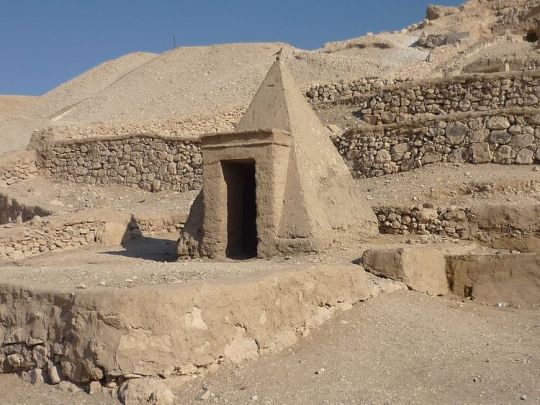
Deir el-Medina
Deir el-Medina is the modern Arabic name for the worker's village (now an archaeological site) which was home to the artisans and craftsmen of Thebes who built and decorated the royal tombs in the nearby Valley of the Kings and Valley of the Queens.
The ancient inhabitants called the village Pa Demi (“the village”) but it was referred to in official correspondence as Set-Ma'at (“The Place of Truth”) because the workers there were thought to be inspired by the gods in creating the eternal homes of the deceased kings and their families. Early in the Christian era the village, then deserted, was occupied by monks who took over the Temple of Hathor for use as a cloister. The temple was referred to as Deir el-Medina (“Monastery of the Town”) and this name finally came to be applied to the entire site.
Unlike most villages in ancient Egypt, which grew up organically from small settlements, Deir el-Medina was a planned community. It was founded by Amenhotep I (c.1541-1520 BCE) specifically to house workers on royal tombs because tomb desecration and robbery had become a serious concern by his time. It was decided that the royalty of Egypt would no longer advertise their final resting places with large monuments but, instead, would be buried in a less accessible area in tombs cut into the cliff walls. These areas would become the necropolises now known as the Valley of the Kings and the Valley of the Queens and those who lived in the village were known as “Servants in the Place of Truth” for their important role in creating eternal homes and also remaining discreet regarding tomb contents and location.
Deir el-Medina is among the most important archaeological sites in Egypt because of the wealth of information it provides on the daily life of the people who lived there. Serious excavation at the site was begun in 1905 CE by the Italian archaeologist Ernesto Schiaparelli and furthered by a number of others throughout the 20th century CE with some of the most extensive work done by French archaeologist Bernard Bruyere between 1922-1940 CE. At the same time Howard Carter was bringing the treasures of the royalty to light from Tutankhamun's tomb, Bruyere was uncovering the lives of the working people who would have created that final resting place.
History of the Village
The earliest extant ruins at the site are from the reign of Thutmose I (1520-1492 BCE), son and successor of Amenhotep I, but there is no doubt that it was Amenhotep I who first planned the site. He and his mother, Ahmose-Nefertari, were worshipped as protective gods at the site throughout its history. The workers also venerated the cobra goddess Meretseger (whose name means “She Who Loves Silence”), the personification of the Theban necropolis and protector of the dead and, especially, of their tombs.
By the time of the New Kingdom (c.1570-c.1069 BCE) tomb robbing had become almost epidemic in scope. Although measures such as false doors and labyrinths had been a part of tomb building since the Old Kingdom (c.2613-2181 BCE) they were not effective in keeping robbers from reaching the burial chamber and the vast treasures left there with the deceased. One gains an understanding of exactly how great the wealth in these tombs was when one considers the treasures of Tutankhamun's tomb discovered by Howard Carter in 1922 CE. Tutankhamun died before he was 20 years old and had not yet amassed the kind of wealth a king like Djoser (c.2670 BCE) or Khufu (2589-2566 BCE) would have had entombed for the afterlife.
The Valley of the Kings was selected as the new necropolis for royalty and the village was planned for easy access (a half hour's walk) from a worker's home to the tombs. The village was in continuous use from the time of Thutmose I until the collapse of the New Kingdom in c. 1069 BCE. Although the community and nearby necropolises were planned to safeguard the tombs of the kings, human greed and opportunity would eventually work to undermine the plan and some of the workers themselves would turn to robbing the tombs they had helped build and protect for an easy and quite substantial payoff. For most of its history, however, the village seems to have functioned as it was intended.
Continue reading...
26 notes
·
View notes
Text
Burden of Truth (Book 1) Chapter Eleven
Father Figure! Marc Spector x Teen! Reader
Father Figure! Steven Grant x Teen! Reader
Mother Figure! Layla El-Faouly x Teen! Reader
Chapter Eleven: At the Sarcophagus
Summary: (Y/N) and Steven find the Sarcophagus of Ammit's Avatar, but Harrow finds it, too.
Mouse Note: Listen...I can't say I'm sorry, but, uh, yeah.
(Y/N) and Steven continued on their way through the new tunnel. It was a bit caved in with bits of rock fallen in their way, but nothing impeded them severely. Finally, they rounded a corner, and another chamber opened up.
“Oh my stars,” said Steven.
“My god,” said (Y/N).
They stared at the room, lit by a ray of sunshine reflected off pools and trickles of water. Stepping over rocks, they approached the burial chamber of the pharaoh. Statues and murals lined the walls, and the sarcophagus itself stood on a dais in the center of the room.
Steven stared at the artifacts. “Thutmose III. Nefertiti. It’s gotta be one of the big ones.”
“You nearly kissed her,” said Marc, and Steven stumbled.
“Steven?” asked (Y/N).
“Just Marc talking,” said Steven, trying to ignore him as they continued.
(Y/N) frowned and looked at his reflection in the water. They wished they could still hear Marc. It was lonelier without him. They wished they could be with Layla, Steven, and Marc all together again.
“I should try to drown you or punch you again,” said Marc. “But you also told her the truth about why I’ve been pushing her away. And that was unexpected. And you protected (Y/N).” So he wouldn’t try to hit Steven.
“Are these Macedonian?” said (Y/N), unknowingly interrupting the conversation. They knelt by the relics and murals. “I can’t remember these symbols or translate them, but these are Macedonian, aren’t they?”
Steven knelt next to them. “No way. That’s impossible. Only one pharaoh…But he called himself Egyptian.”
(Y/N)’s eyes widened. “No way. No way. Is this really…?”
“I think we’re looking at the long-lost tomb of Alexander the Great,” breathed Steven, giddy and reverent all at once.
(Y/N) stared at it. “…Oh god. We have to open the sarcophagus.” It felt wrong to disturb the tomb, but this was Ammit’s tomb. Alexander the Great had been her Avatar. She needed to be stopped. Harrow needed to be stopped.
“That just feels wrong,” groaned Steven. “Everything inside of me is screaming not to open this thing.”
“You want Harrow to get to Ammit first?” said Marc.
“Of course I don’t want him to get to Ammit,” said Steven.
“Marc again?” said (Y/N).
“Yeah,” said Steven. He looked at (Y/N). “Ready?”
“As I’ll ever be,” said (Y/N).
Steven nodded. Together, they put their hands on the lid of the sarcophagus and pushed. It was tough going, but they managed to shit the top end of the lid off enough so that they could see the mummy within. This was the Alexander the Great. In the flesh (literally, since he was a mummy).
“Where’s the ushabti?” said Marc.
“He’s not holding the ushabti,” said (Y/N) at the same moment, frowning.
Steven nearly smiled at the coincidence and answered both at once. “If you’re gonna hide it for all eternity, you’d probably put it in a place where the average looter wouldn’t think to look.”
(Y/N) coughed and pulled up their sleeves. “Um, I think I know where.”
“Where?” said Steven and Marc at the same time, though (Y/N) could only hear one.
“It’s the voice symbolism again,” said (Y/N), grimacing and gesturing to the wrapped head and throat of Alexander the Great.
“Oh. Oh, gross,” said Steven.
(Y/N) steeled themself, reached out, and pulled away the wrappings around Alexander the Great’s face. “I am so sorry,” they muttered to the mummy and the memory of their parents. They shouldn’t be disturbing a resting place like this. But it needed to be done.
“Oh…” Steven grimaced as (Y/N) slipped their hand into Alexander the Great’s mouth and reached into his throat.
Forcing themself not to retch, (Y/N) felt a wave of relief as they felt a stone sculpture. Grabbing it, they pulled it out. The sunlight illuminated the return of Ammit’s ushabti to the world.
“We found it,” breathed Steven.
“Good job, kid,” said Marc, unable to hold back the pride. He deflated as he remembered (Y/N) couldn’t hear him now.
(Y/N) nodded and smiled at Steven in relief.
Footsteps approached, and they tensed, whirling toward the passage. They relaxed as they saw it was Layla. She had made it.
“Layla, look!” said Steven proudly, gesturing to the ushabti in (Y/N)’s hands. “We won!” He laughed.
(Y/N) frowned. Layla’s eyes were narrowed, and her body was tense as she came closer. Something was off.
“(Y/N) had to reach down Alexander the Great’s throat, but we found it,” said Steven. He frowned as he finally saw Layla’s furious gaze. “You alright, love?”
“Can he hear me?” she snapped.
“Alexander? No, I don’t think so. God, I hope not,” chuckled Steven, trying to keep the good energy going.
Layla kept going. “What happened to my father?”
(Y/N) frowned and flinched. They didn’t like the feeling that was appearing in the room. Everything had been going fine. And now, now, something was wrong. (Y/N) stepped back.
Layla walked up to Steven. “I’m talking to you.”
“What?” asked Steven.
“I’m talking to you, Marc,” snapped Layla, trying to get him to come out and speak to her.
Steven frowned, his eyes rolled up, and when Layla had him looking at her again, it was Marc staring out. He had gotten control of the body.
“Come on, come on, let’s go,” said Marc, trying to take control of the situation and avoid the conversation. He took (Y/N)’s arm and Layla’s hand, but Layla pulled back.
“No,” she said forcefully.
“We need to go right now,” said Marc.
“What’s going on?” said (Y/N), pulling the end of their sleeves.
“Marc, no. No,” repeated Layla, refusing to go with him. “What happened to my father?!”
“Listen to me. We need to leave right now,” said Marc. “I will explain everything, I swear. But we have to go.”
“He’s telling the truth,” said (Y/N), trying to help but unsure of themself.
“No, I want to know now,” said Layla. She glared at Marc. “Did you kill Abdullah El Faouly?!”
(Y/N)’s eyes widened, and their gaze snapped to Marc. Their chest constricted as the terrible question was left in the air.
“Of course not. Of course I didn’t!” said Marc.
“He’s…He’s telling the truth,” said (Y/N). “He didn’t kill him, Layla.”
“But he was there,” said Layla, seeing that Marc was evading the whole truth. “Weren’t you?”
“Marc?” asked (Y/N), looking at him.
“I—” Marc couldn’t answer. Lying was impossible, but the truth was painful. It would destroy everything he’d built with Layla and whatever had started to grow between (Y/N) and Marc.
“Yeah, you were there,” said Layla. She could read him clearly.
Marc swallowed. Softly, he admitted the terrible truth. “I was there. Yeah. I was there.”
“Yeah. And how did he die?” snapped Layla.
(Y/N) covered their mouth and stepped back. “The mercenaries and the archaeologists.” What Fitzgerald and Kennedy had said in the car.
“Kid—” Marc reached out to them, but he let his hand drop. “I—My partner got greedy.” He spoke quietly, tiredly, as everything he’d never wanted to admit forced itself to the surface and destroyed what he’d built. “He executed everyone at the dig site. I tried to save your father, Layla, but I couldn’t. And I—”
Layla glared at him. “No. But you brought a killer right to him. Right?” She shoved him back, and Marc just took it.
He nodded helplessly, willing to take any abuse to make up for the terrible things he’d done. “Yeah. He shot me, too. I was supposed to die that night. But I didn’t die that night. And I should have.” Marc gazed at Layla with so much emotion as she wiped tears from her cheeks. “I’ve tried to tell you since the moment we met. But I just didn’t know how.”
Layla sobbed. Then, she froze. “Oh my god.”
“I’m sorry,” said Marc.
Layla turned on him. “That’s the reason we met.”
(Y/N)’s eyes widened, and they clutched the ushabti tightly.
“You just had a guilty conscience?” said Layla incredulously, and the way Marc stared back at her was answer enough.
“Layla—”
The sound of a rolling stone broke through the moment, and they all turned towards the passageway. The rustle of footsteps grew louder.
“They’re here,” said Marc in alarm.
“There must be another way out,” said Layla, wanting to stay alive to keep being angry.
“Okay, go, find it. Take (Y/N). I’ll hold them off,” said Marc, grabbing an ornamental axe from the sarcophagus.
At the same time, (Y/N) took their moment to go with Layla to stuff the ushabti into the backpack to hide it from sight. The moment that Layla darted to grab (Y/N), though, Harrow and his numerous armed men stepped into the room. Layla had to hide behind a column, and as (Y/N) tried to scramble back, a guard that had snuck around the side grabbed them. (Y/N) yelped. Marc’s eyes widened, and he took a step towards (Y/N) but froze as the guard held (Y/N) tightly and raised his gun. They kicked at him, but the man was stronger, and (Y/N) was stuck staring fearfully at Marc.
“Be gentle with them. They’re just misguided,” said Harrow to the guard.
(Y/N) and Marc’s eyes went to Harrow as he stood in the tomb with them. The scarab that had guided him there fell into his hand, the magic having done its job.
“Just you two, isn’t it?” said Harrow. “The rest is silence.” He strolled closer. “I remember the first morning I woke up knowing that Khonshu was gone. The quiet was liberating. You’re both free. And, of course, with that freedom comes choice. And right now, you both have a very important decision to make.”
Harrow walked towards (Y/N), and Marc tensed. He smiled at them, and (Y/N) flinched. “I know it’s been hard.” (Y/N) fought to avoid his gaze. “Being used by the gods. Pushed so far. Being so alone. But you can be alright, now.” They shook their head furiously. “You have nothing to worry about. You can let go of all the pain you feel. All the blame you feel.” He smiled kindly. “I know you think your parents’ death is your fault.” (Y/N)’s eyes widened, and they let out a sound akin to a whimper, a desperate plea for him to stop. “You asked for them to show you Egypt. You begged them to take you to the place they’d met, fallen in love, worked and learned. And then they died.” Harrow reached out and put a hand on (Y/N)’s head, and they winced back. “That’s alright.” He removed his hand and took theirs into his.
Marc and Layla’s eyes widened as the cane began to swing back and forth. (Y/N)’s soul was being judged.
“Stop it,” shouted Marc, taking a step forward, but the guns raised and pointed at him.
(Y/N) was tempted to shut their eyes as the scales tattoo weighed back and forth. Unable to avert their eyes, though, (Y/N) watched as it settled. Their eyes widened. The scales were green. Their soul had been deemed worthy.
Harrow smiled. “I knew I had a good feeling about you.” He took back his cane and gazed at (Y/N). They reluctantly looked up at him. “Now the choice lies before you. You have been deemed worthy. Ammit wants you on her side. You can help relieve the pain of so many. You can have a purpose.”
(Y/N) stared at him, that word pulling at them, twisted around their heart and lungs. Their eyes flicked to Marc, staring at them with such worry that they felt their heart stir despite the pressure on it. (Y/N) looked back at Harrow evenly.
“I will never join you or Ammit,” said (Y/N), the words as honest as could be.
Harrow sighed. “I’m disappointed. Nonetheless, I’m afraid I can’t let you and live freely just yet.” He smiled. “We need the ritual to release Ammit.”
(Y/N) froze, and their eyes widened. Long ago, Ma’at had taught them different rituals, bits of ancient magic that might one day be needed. One was to release the gods from ushabtis. (Y/N) hadn’t understood the significance then, nor had they questioned why Ma’at wanted them to learn it, but now that Ma’at was imprisoned, (Y/N) understood. Ma’at had known her actions in the mortal world could get her imprisoned. She had made sure the Avatar she had basically raised would be able to come and free her.
Unfortunately, now, that meant (Y/N) could also free Ammit.
“Leave them alone,” said Marc forcefully.
Harrow turned to him with a smile. “After I bring Ammit to this world and allow her to create a better one, (Y/N) can live a life free of danger and worry. I just need them for a little while longer.” Harrow gestured to them. “And you could be a part of that world, too. You just need to do the right thing.”
Marc looked at (Y/N) and then at all the armed men. He knew how to answer. He grabbed the gun of one man and dragged him closer. The man stumbled, and Marc slammed the axe onto his arm before he could shoot. He slashed at the next closest man, and then he threw the axe at Harrow.
One of his guards stepped it front and took the blow, loyal until death. The man fell, and Harrow pulled something from the man’s belt as the guard fell. Harrow looked evenly at Marc, raised the pistol, and shot.
Bang!
(Y/N) screamed as Marc stumbled back, blood pooling on his white shirt.
“Marc!” they cried, trying to pull away from the guard. “No! Marc, Steven!” They screamed for both desperately, tears burning at their eyes.
Harrow stepped up and raised the pistol again.
“Please, please, please, no!” shouted (Y/N).
Bang!
Behind the column, Layla covered her mouth as tears spilled down her cheeks. (Y/N) let out another agonized scream. The second wound bled instantly, and Marc fell back. He collapsed off the dais of the sarcophagus and landed in the pool of water.
“I can’t save anyone who won’t save themselves,” said Harrow, daring enough to be saddened.
(Y/N) let out a sob as Marc’s body lay in the water, unmoving. He was gone. Steven was gone. The tiny bit of good and warmth and connection (Y/N) had gathered in their life had been ripped away once again.
(Y/N) was alone.
Taglist:
@jaytheaceenby
@severussimp
@dmitrytherat
@slytherinroyalty16
@grippleback-galaxy
@alexpangender
@thewittyfanficreader
@aew-kun-age-regression
@oscarissac2099
@amberforest08
@kyalov
@yyourmotherr
@im-making-an-effort
@the-toskaverse
@wra-1-th
#burden of truth#x reader#x gn reader#gn reader#nb reader#x nb reader#x teen!reader#x teen reader#found family#found family trope#father figure#teen reader#teen!reader#platonic x reader#platonic#platonic moonknight#platonic moon knight#moonknight x reader#moonknight x teen!reader#moonknight x teen reader#moonknight#moon knight x teen reader#moon knight x teen!reader#moon knight x reader#moon knight#marvel moonknight#marvel moon knight#mcu#marvel x reader#marvel cinematic universe
48 notes
·
View notes
Text
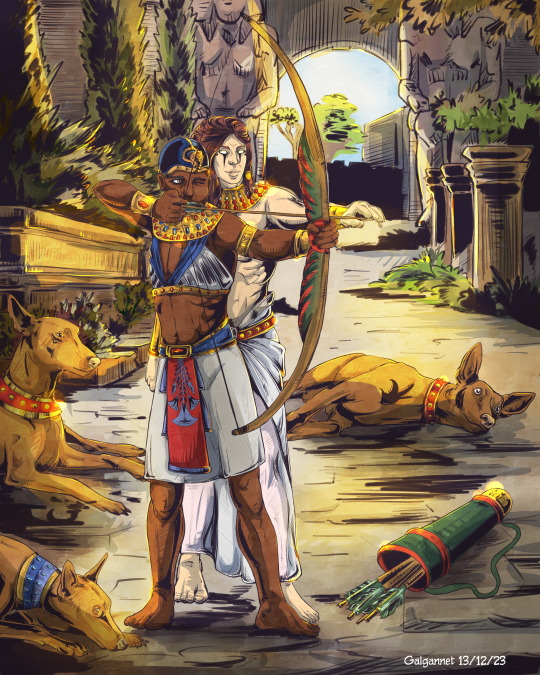
Thutmose III or better known as Thutmose the Great, is taking archery lessons from the slayer of the dark serpent, the one and only, Lord of the Red Land, Seth.
Even great kings have to start somewhere and why not ask your divine family for help and advice?
The dogs certainly don't mind the extra company.
This is my own interpretation of the Theben wall relief showing the God Seth teaching the king archery.
Thanks to my wife for getting me into this.
I have previously portrayed Lord Set here and here.
Artstation | Deviantart | VK | Commission List
#galgannet#illustration#comic book style#ancient egypt#egyptian art#ancient history#egyptian#Pharaoh Tuthmosis III#god Seth#фараон#Lord Seth
40 notes
·
View notes
Text

Lotus pendant of vizier Imhotep
New Kingdom, early-18th Dynasty, ca. 1493-1482 BC.
Tomb of vizier Imhotep (QV46), Valley of the Queens, Thebes.
Egyptian Museum of Turin. S. 5108
A lotus flower shaped pendant once belonged to the Vizier Imhotep, a high official in the royal court of King Thutmose I. Excavated by Ernesto Schiaparelli and Francesco Ballerini.
The lotus was shown throughout Egypt in tombs and temples to symbolize the union of Upper and Lower Egypt. It symbolizes the sun, creation, and rebirth because at night, the flower closes and sinks underwater, at dawn it rises and opens again.
In ancient Egypt there were two kinds of lotus flowers, a blue and a white one. The blue was the most sacred and was greatly appreciated, with its delicate and sweet aroma. Egyptians imagined this flower as a goblet, which opened on the water as the cradle of the sun in the morning.
Read more
31 notes
·
View notes
Text
If you had told me that there was a three and half thousand year old Egyptian obelisk in Central Park I would have thought you were crazier than some of the people I’ve encountered in Harlem. But now that I’ve seen it with my very own eyes I guess I have no choice but to believe it…



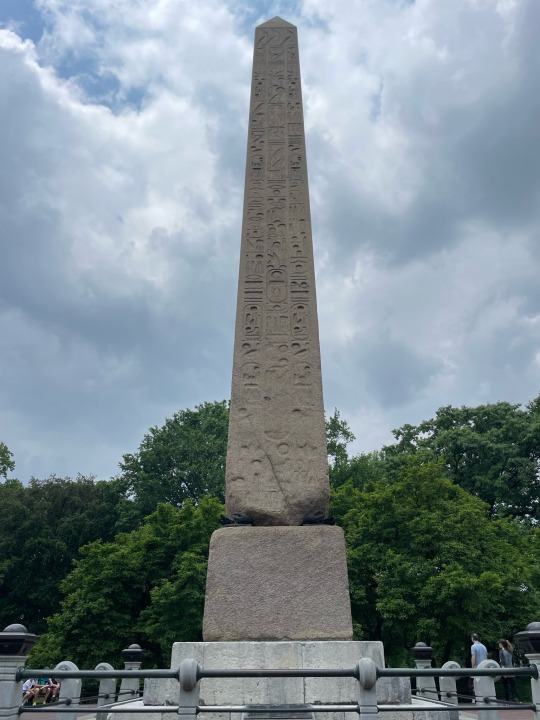
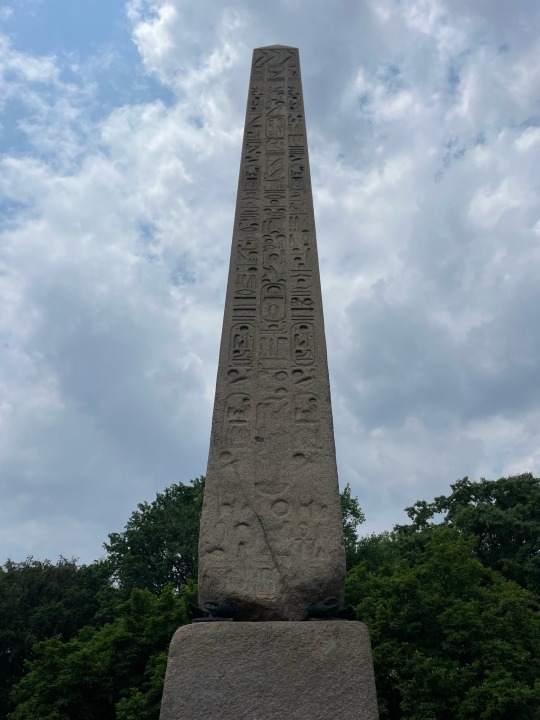


The Obelisk (known as Cleopatras Needle) was created around 1425 BC in Heliopolis - an area north of modern day Cairo in Egypt - but now sits upon a rocky hill known as the Greywacke Knoll located behind the Metropolitan Museum of Art. This is the third place that this 220 ton monolith could call home. Originally it was located at the Temple of the Sun in Heliopolis after having been commissioned by Pharaoh Thutmose III and subsequently carved out of a single piece of stone.
When the ancient Romans discovered it in 12 BC it had toppled over and was partially buried in the sand. The Romans then transported it to Alexandria and built the bronze crabs that act as supports for the damaged obelisk before having it installed at the entrance to a temple dedicated to Julius Caesar - a temple which had been built by Cleopatra (hence the name Cleopatra’s Needle)
It then found its way to NYC in the 1870s when the Egyptian government gifted the obelisk to the United States in commemoration of the opening of the Suez Canal.
59 notes
·
View notes